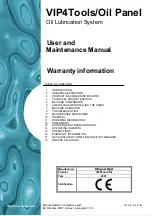
OWNER’S MANUAL: TT & WT and ECOA HTT & HUE Series
—
Page 9
D. TESTING THE TILTER WITH NO LOAD
Before operating the tilter, read and understand this section.
1. Before testing the tilter, clear the area of any loose mate-
rial. Be sure the tilter has no obstruction above it or on
any side. Using the controls provided, briefly operate
the tilter (5-10 seconds). If the tilter begins to rise with
a humming sound and functions properly, continue to
the full upright position.
CAUTION!
If the tilter does not rise immediately, or there is
any operational problem, stop it immediately. Be-
fore continuing, check the rotation of the pump
and motor and the voltage at motor terminals,
again briefly operate the tilter. If the tilter does
not move smoothly with the humming sound,
stop and review the procedures in the section
on troubleshooting (Section 5B).
2. After raising the tilter completely, lower the tilter com-
pletely. It should move slowly and smoothly without a
humming sound. If the tilter operates properly, raise
and lower the tilter and stop at different levels in order
to familiarize yourself with the tilter’s operations and
movements.
WARNING!
As the tilter platform and forks move up and
down, pinch points are created at locations near
the base of the frame. While operating the tilter
the operator should be standing clear of the tilter
and container while in use. In that way, the op-
erator’s arms, legs or clothing will not be caught
in the moving parts. During operations the op
-
erator should avoid the pinch point areas which
are located on either side of the tilter. See the
diagram pointing out the particular pinch points.
S E C T I O N 4
OPERATION
A
. METHOD OF OPERATION
All tilters are provided with a special hydraulic relief valve,
which is factory preset to the maximum safe capacity of the
container tilter (see the nameplate attached to the tilter.)
Activating and holding the up switch will energize the motor.
The motor is attached to a positive displacement pump which
draws hydraulic fluid from the reservoir and transfers it under
pressure to the cylinder. This forces the piston forward and
the raise to rise in a thirty (30º) to ninety degree (90º) arc.
Releasing the up button will stop the tilter. A check valve
between the pump and piston holds the platform in position.
Depressing and holding the down button of the switch will
energize a solenoid, which allows the oil from the cylinder
to return to the reservoir through a preset flow control. This
allows the tilter to lower smoothly and at a controlled speed.
CAUTION!
Do not
maintain the up button on the switch en
-
ergized if the tilter does not move or has reached
its upper limit. This may cause damage to the
motor, pump and controls.
B. OPERATION PROCEDURES
In order to operate the tilter, follow these operating proce-
dures:
1. Read and understand all the instructions before op-
erating. If the tilter has modifications or accessories,
read and understand their functions.
2. Load the tilter correctly. Refer to the attached name-
plate for load capacity information.
a) Load the tilter while it is in the lowered position.
b) Do not
exceed the maximum rated load (note
that load capacity is on the nameplate of the
tilter).
c) Place the load in the center and at the very back
of the platform (pivot end).
d) If the load is unstable or may become unstable,
fasten it into position.
e) Use additional precautions when tilting a load
of loose parts. Excessive (what?) can cause
parts to fall out of the container.
3. Operate the tilter.
a) To raise the tilter, press and hold the up button
on the switch.
b) To lower the tilter, press the down button on the
switch.
c) Release the button to stop the tilter in either
direction.
4. Wait until the tilter has come to a complete stop
before loading or unloading.
5. Stand clear of the tilter when operating in order to
avoid injury.




































